19+ Indian Independence Day Speech Examples
An Indian Independence Day Speech is a formal address delivered on the 15th of August each year to commemorate India’s independence from British rule, which was achieved on August 15, 1947. This speech typically highlights the significance of the day, honors the sacrifices of freedom fighters, and emphasizes the values of freedom, unity, and patriotism. It is often delivered by leaders, such as the Prime Minister, school principals, teachers, and students, during various celebratory events across the country.
What is Indian Independence Day Speech?
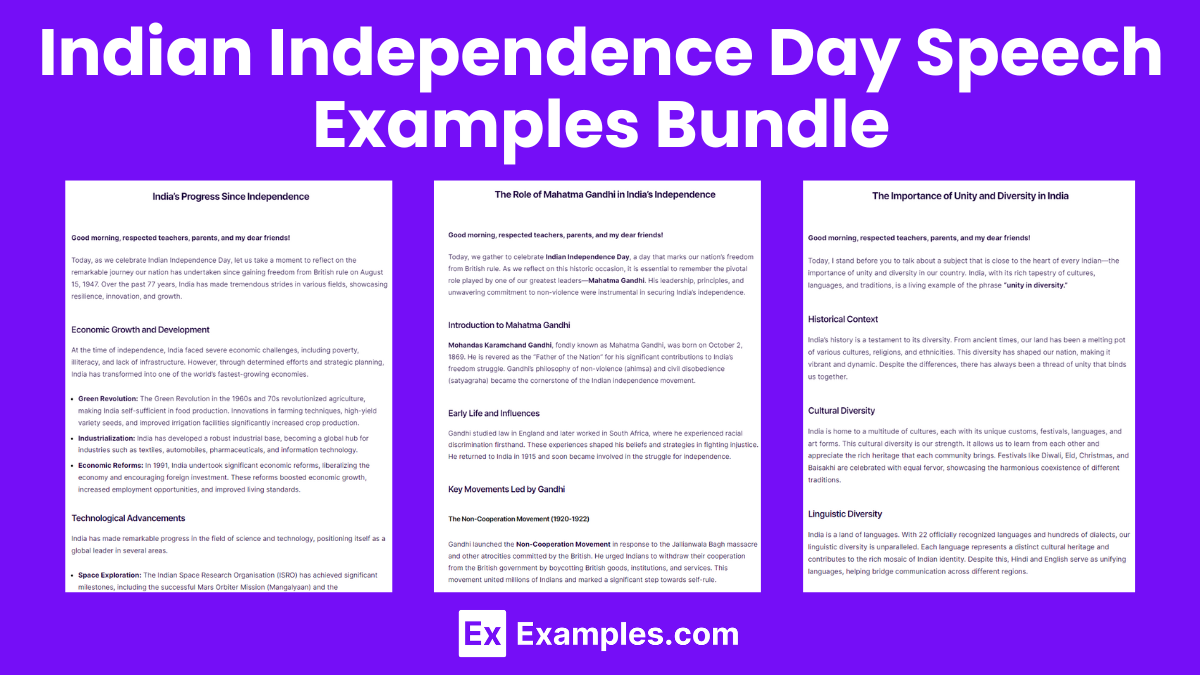
Indian Independence Day Speech Bundle Download
Indian Independence Day Speech Format
1. Introduction
Greeting: Start with a respectful and warm greeting to the audience.
Acknowledgement: Acknowledge the significance of the day and the presence of dignitaries, teachers, parents, and students.
2. Historical Context
Background: Briefly describe the history leading up to August 15, 1947.
Freedom Struggle: Highlight key events and movements in the struggle for independence.
Key Figures: Mention prominent leaders like Mahatma Gandhi, Jawaharlal Nehru, Sardar Patel, and others.
3. Celebrating Freedom
Significance: Discuss the importance of freedom and what it means for the nation.
Progress Since Independence: Highlight achievements in various fields such as technology, education, and economy since gaining independence.
4. Unity and Diversity
Cultural Heritage: Emphasize India’s diverse culture and how it contributes to the nation’s unity.
National Pride: Encourage a sense of pride in being Indian and the values that unite the country.
5. Challenges and Responsibilities
Current Challenges: Address the challenges the nation faces today.
Role of Citizens: Discuss the responsibilities of citizens in upholding the values of freedom and democracy.
6. Inspirational Messages
Quotes and Anecdotes: Include inspiring quotes from freedom fighters and leaders.
Motivational Thoughts: Encourage the audience to contribute to the nation’s growth and development.
7. Conclusion
Summary: Summarize the key points discussed in the speech.
Call to Action: End with a motivating message or call to action for the audience to take pride in their country and work towards a better future.
Closing Remarks: Thank the audience for their attention and participation.
Indian Independence Day Speech Example
Good morning, respected teachers, parents, and my dear friends!
Today, we gather to celebrate a very special day in our nation’s history—Indian Independence Day. This day marks the anniversary of our freedom from British rule on August 15, 1947. It is a day to remember our past and honor the sacrifices made by countless freedom fighters who fought bravely to make India a free and independent nation.
Historical Context
On this day, 77 years ago, India gained independence after a long and arduous struggle. Our leaders, including Mahatma Gandhi, Jawaharlal Nehru, Sardar Vallabhbhai Patel, and many others, led the nation with courage and determination. They faced numerous challenges and hardships but never gave up on their dream of a free India.
Celebrating Freedom
Independence Day is not just a holiday; it is a day of great significance. It reminds us of the value of freedom and the importance of unity and resilience. Since 1947, India has made tremendous progress in various fields such as technology, education, and healthcare. Our nation has grown stronger and more vibrant, reflecting the true spirit of independence.
Unity and Diversity
India is a land of diverse cultures, languages, and traditions. Our diversity is our strength, and it unites us as a nation. On this day, we celebrate the rich cultural heritage that makes India unique. We must continue to uphold the values of unity, tolerance, and respect for all, which are the pillars of our democracy.
Challenges and Responsibilities
While we celebrate our achievements, we must also acknowledge the challenges that lie ahead. As responsible citizens, it is our duty to work together to overcome these challenges. We must strive to eliminate poverty, improve education, and ensure that every citizen enjoys the benefits of freedom and democracy.
Inspirational Messages
Let us draw inspiration from the words of Mahatma Gandhi: “The best way to find yourself is to lose yourself in the service of others.” Each one of us has a role to play in building a better future for our country. By working together, we can make India a nation that stands tall on the global stage.
Conclusion
In conclusion, let us take pride in our nation’s achievements and commit to contributing positively to its future. Let us remember the sacrifices of our freedom fighters and honor their legacy by upholding the values of freedom, justice, and equality.
Thank you for your attention. Happy Independence Day!
Short Indian Independence Day Speech Example
Good morning, respected teachers, parents, and my dear friends!
Today, we gather to celebrate a very special day in our nation’s history—Indian Independence Day. On August 15, 1947, India became free from British rule, thanks to the sacrifices of countless freedom fighters.
Historical Context
Leaders like Mahatma Gandhi, Jawaharlal Nehru, and Sardar Patel fought tirelessly for our freedom. Their bravery and determination paved the way for our independence.
Celebrating Freedom
Independence Day is a reminder of the value of freedom and the progress we have made as a nation. Since 1947, India has achieved great advancements in technology, education, and healthcare.
Unity and Diversity
India’s strength lies in its diversity. Our country is a beautiful mosaic of different cultures, languages, and traditions. This unity in diversity is what makes India special.
Responsibilities as Citizens
As we celebrate, we must also remember our responsibilities. Let us work together to overcome challenges and build a better future for our country. Each one of us has a role to play in making India stronger and more prosperous.
Conclusion
In conclusion, let us honor the sacrifices of our freedom fighters and take pride in our nation’s achievements. Let’s commit to upholding the values of freedom, justice, and equality.
Thank you for your attention. Happy Independence Day!
India’s Progress Since Independence
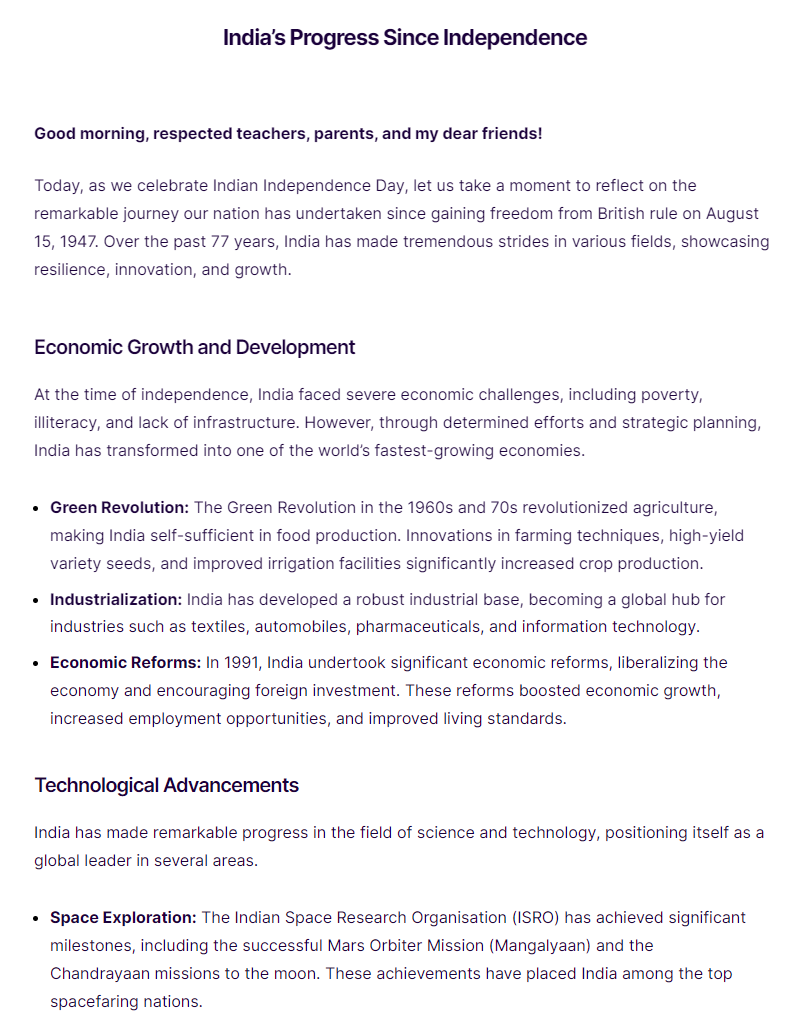
The Role of Mahatma Gandhi in India’s Independence
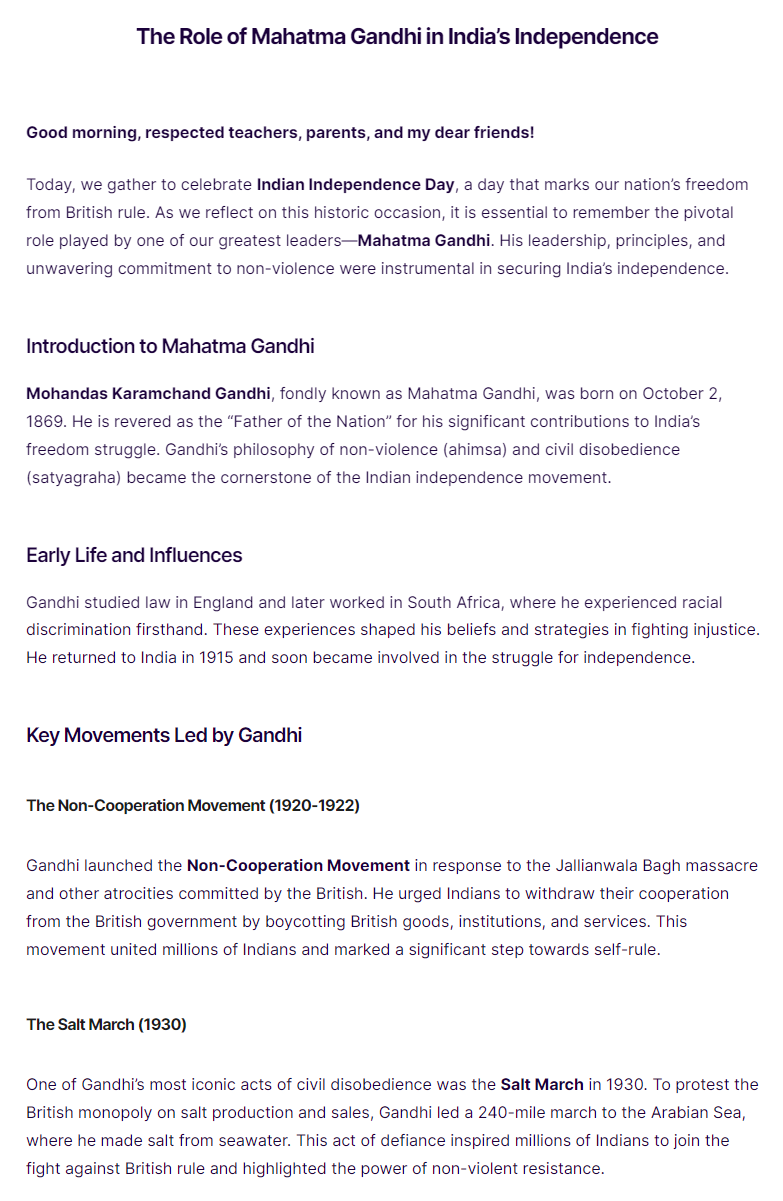
The Importance of Unity and Diversity in India
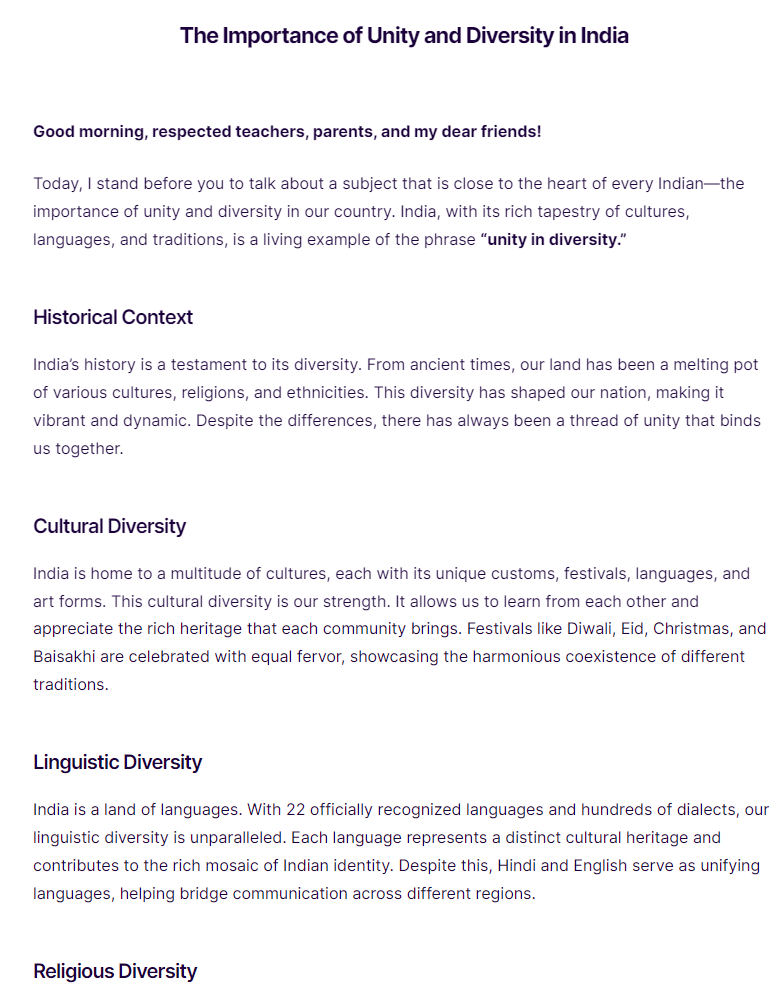
How to Write Indian Independence Day Speech
1. Introduction
Greeting: Start with a respectful and warm greeting.
Acknowledgment: Mention the significance of the day.
2. Historical Context
Brief History: Summarize the struggle for independence.
Key Figures: Highlight important leaders like Mahatma Gandhi, Jawaharlal Nehru, and Sardar Patel.
3. Celebrating Freedom
Significance: Explain the importance of Independence Day.
Achievements: Mention key achievements since independence.
4. Unity and Diversity
Cultural Diversity: Emphasize India’s diverse culture.
National Unity: Highlight the importance of unity in diversity.
5. Responsibilities as Citizens
Civic Duty: Discuss the responsibilities of citizens.
Future Vision: Encourage working towards a better future.
6. Conclusion
Summary: Recap key points.
Inspirational Message: End with a motivational and patriotic message.
More Indian Independence Day Speech Topics
- India’s Progress Since Independence
- The Role of Mahatma Gandhi in India’s Independence
- The Importance of Unity and Diversity in India
- Honoring the Freedom Fighters of India
- The Future Vision for India
- Achievements in Indian Science and Technology
- India’s Economic Growth Since 1947
- The Evolution of Indian Democracy
- Women’s Contribution to India’s Independence Movement
- India’s Cultural Heritage and Its Global Impact
- Educational Reforms in Independent India
- Indian Independence and Its Impact on Art and Literature
- Environmental Policies in Independent India
- India’s Healthcare System: Progress and Challenges
- India’s Contribution to Global Peace and Security
- The Impact of Indian Independence on Global Politics
- India’s Achievements in Space Exploration
- India’s Fight Against Poverty Since Independence
Tips for Indian Independence Day Speech
- Start with a Warm Greeting: Engage your audience from the beginning with a respectful and enthusiastic greeting.
- Highlight the Significance: Explain why Independence Day is important and what it commemorates.
- Include Historical Context: Briefly mention the struggle for independence and key figures like Mahatma Gandhi and Jawaharlal Nehru.
- Celebrate Achievements: Discuss the progress India has made since gaining independence in areas like technology, education, and healthcare.
- Emphasize Unity in Diversity: Talk about India’s diverse culture and how it contributes to national unity.
- Incorporate Personal Stories or Quotes: Use relevant anecdotes or inspirational quotes from leaders to add a personal touch.
- Keep It Concise: Ensure your speech is short and to the point to keep the audience engaged.
- Use Simple and Clear Language: Avoid jargon and use language that is easy for everyone to understand.
- Inspire Civic Responsibility: Encourage the audience to uphold democratic values and contribute positively to society.
- End with a Strong Conclusion: Summarize your key points and leave the audience with an inspiring message or call to action.
Uses of Indian Independence Day Speech
- Commemorating Historical Events: An Indian Independence Day speech highlights the historical significance of August 15th. It recounts the struggle for independence, the efforts of freedom fighters, and the sacrifices made, reminding citizens of the nation’s journey to freedom.
- Promoting National Unity: These speeches emphasize the importance of unity and solidarity among Indians. By reflecting on the collective effort that secured independence, they inspire citizens to work together for the common good, fostering a sense of belonging and community.
- Honoring National Heroes: Independence Day speeches honor the sacrifices and contributions of national heroes and freedom fighters like Mahatma Gandhi, Jawaharlal Nehru, Sardar Vallabhbhai Patel, and many others. They acknowledge the individuals who fought for freedom, ensuring their legacy is remembered and respected.
- Inspiring Patriotism: The primary aim of these speeches is to evoke a sense of patriotism and national pride. They highlight the country’s achievements, values, and strengths, encouraging citizens to contribute positively to the nation’s development.
- Addressing Current Issues: Leaders use Independence Day speeches to address current national issues and challenges. By discussing these topics, they can rally support, propose solutions, and inspire collective action to overcome difficulties.
- Setting Future Goals: These speeches often outline the nation’s future goals and aspirations. Leaders use the occasion to present their vision for the country, motivating citizens to strive for progress and prosperity.
- Educational Purpose: Independence Day speeches educate the younger generation about the significance of independence and the values of freedom, democracy, and justice. They serve as a reminder of the importance of preserving and upholding these values.
- Strengthening Cultural Identity: These speeches celebrate the nation’s cultural heritage and identity. They recognize the diverse traditions and customs that contribute to India’s uniqueness, promoting cultural pride and inclusivity.
- Encouraging Civic Responsibility: Independence Day speeches emphasize the role of citizens in maintaining and strengthening democracy. They encourage civic responsibility, active participation in governance, and adherence to national laws and principles.
- Fostering International Relations: Leaders may use Independence Day speeches to address the international community, highlighting India’s diplomatic achievements and its role in global affairs. This fosters goodwill and strengthens international relations.
When is Indian Independence Day celebrated?
India celebrates Independence Day annually on August 15.
What is the significance of Indian Independence Day?
Independence Day commemorates India’s liberation from British colonial rule and honors the sacrifices of freedom fighters.
What typically happens during an Independence Day speech?
Speakers highlight the significance of independence, honor freedom fighters, and reflect on India’s achievements and future goals.
Who delivers the main Independence Day speech in India?
The Prime Minister of India delivers the main speech from the Red Fort in Delhi.
What themes are common in Independence Day speeches?
Common themes include patriotism, unity, progress, and the importance of continuing the nation’s development.
How long is the Prime Minister’s Independence Day speech?
The Prime Minister’s speech typically lasts between 30 to 60 minutes.
What language is the Independence Day speech delivered in?
The speech is usually delivered in Hindi, India’s most widely spoken language.
What preparation is needed for delivering an Independence Day speech?
Preparation involves researching historical events, current national issues, and crafting a message of hope and unity.
How can one make an Independence Day speech engaging?
Include historical anecdotes, quotes from freedom fighters, and emphasize current achievements and future aspirations.
What role does the audience play in an Independence Day speech?
The audience listens, reflects, and feels inspired by the speech, fostering a sense of national pride and unity.
19+ Indian Independence Day Speech Examples
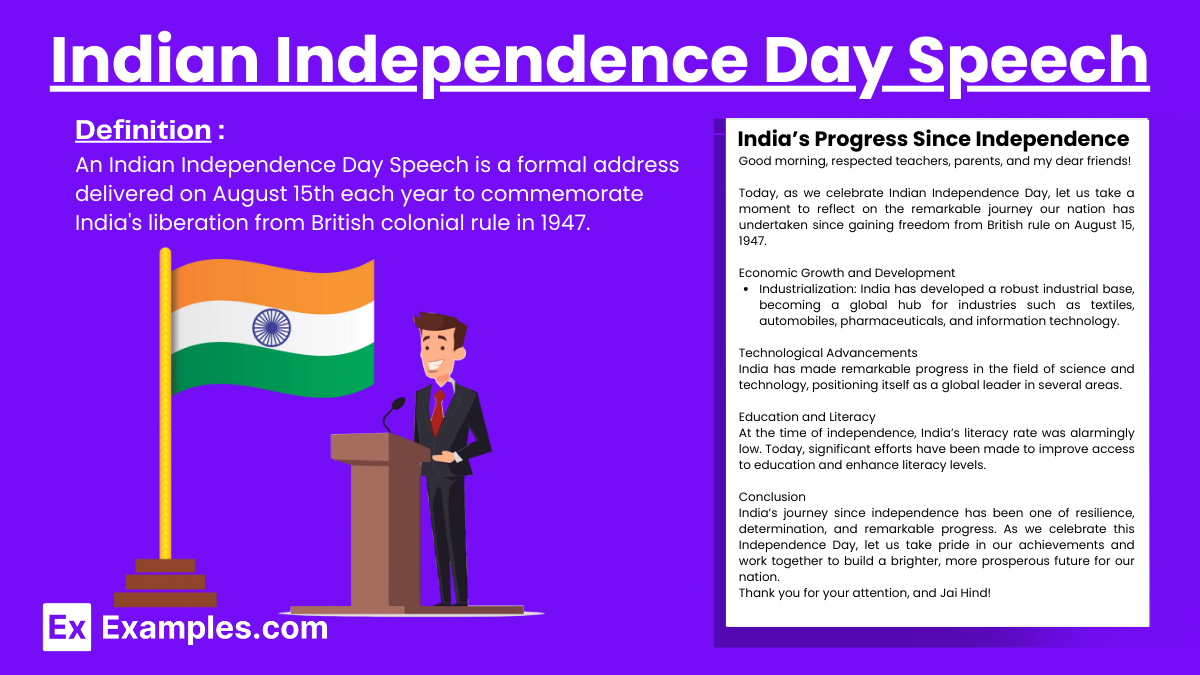
An Indian Independence Day Speech is a formal address delivered on the 15th of August each year to commemorate India’s independence from British rule, which was achieved on August 15, 1947. This speech typically highlights the significance of the day, honors the sacrifices of freedom fighters, and emphasizes the values of freedom, unity, and patriotism. It is often delivered by leaders, such as the Prime Minister, school principals, teachers, and students, during various celebratory events across the country.
What is Indian Independence Day Speech?
An Indian Independence Day Speech is a formal address delivered on August 15th each year to commemorate India’s liberation from British colonial rule in 1947. This speech serves as a reminder of the historical struggle for freedom, honoring the sacrifices and achievements of the nation’s freedom fighters. Delivered by various leaders, educators, and students, the speech underscores the importance of unity, patriotism, and the responsibilities of citizenship.

Indian Independence Day Speech Bundle Download
Indian Independence Day Speech Format
1. Introduction
Greeting: Start with a respectful and warm greeting to the audience.
Acknowledgement: Acknowledge the significance of the day and the presence of dignitaries, teachers, parents, and students.
2. Historical Context
Background: Briefly describe the history leading up to August 15, 1947.
Freedom Struggle: Highlight key events and movements in the struggle for independence.
Key Figures: Mention prominent leaders like Mahatma Gandhi, Jawaharlal Nehru, Sardar Patel, and others.
3. Celebrating Freedom
Significance: Discuss the importance of freedom and what it means for the nation.
Progress Since Independence: Highlight achievements in various fields such as technology, education, and economy since gaining independence.
4. Unity and Diversity
Cultural Heritage: Emphasize India’s diverse culture and how it contributes to the nation’s unity.
National Pride: Encourage a sense of pride in being Indian and the values that unite the country.
5. Challenges and Responsibilities
Current Challenges: Address the challenges the nation faces today.
Role of Citizens: Discuss the responsibilities of citizens in upholding the values of freedom and democracy.
6. Inspirational Messages
Quotes and Anecdotes: Include inspiring quotes from freedom fighters and leaders.
Motivational Thoughts: Encourage the audience to contribute to the nation’s growth and development.
7. Conclusion
Summary: Summarize the key points discussed in the speech.
Call to Action: End with a motivating message or call to action for the audience to take pride in their country and work towards a better future.
Closing Remarks: Thank the audience for their attention and participation.
Indian Independence Day Speech Example
Good morning, respected teachers, parents, and my dear friends!
Today, we gather to celebrate a very special day in our nation’s history—Indian Independence Day. This day marks the anniversary of our freedom from British rule on August 15, 1947. It is a day to remember our past and honor the sacrifices made by countless freedom fighters who fought bravely to make India a free and independent nation.
Historical Context
On this day, 77 years ago, India gained independence after a long and arduous struggle. Our leaders, including Mahatma Gandhi, Jawaharlal Nehru, Sardar Vallabhbhai Patel, and many others, led the nation with courage and determination. They faced numerous challenges and hardships but never gave up on their dream of a free India.
Celebrating Freedom
Independence Day is not just a holiday; it is a day of great significance. It reminds us of the value of freedom and the importance of unity and resilience. Since 1947, India has made tremendous progress in various fields such as technology, education, and healthcare. Our nation has grown stronger and more vibrant, reflecting the true spirit of independence.
Unity and Diversity
India is a land of diverse cultures, languages, and traditions. Our diversity is our strength, and it unites us as a nation. On this day, we celebrate the rich cultural heritage that makes India unique. We must continue to uphold the values of unity, tolerance, and respect for all, which are the pillars of our democracy.
Challenges and Responsibilities
While we celebrate our achievements, we must also acknowledge the challenges that lie ahead. As responsible citizens, it is our duty to work together to overcome these challenges. We must strive to eliminate poverty, improve education, and ensure that every citizen enjoys the benefits of freedom and democracy.
Inspirational Messages
Let us draw inspiration from the words of Mahatma Gandhi: “The best way to find yourself is to lose yourself in the service of others.” Each one of us has a role to play in building a better future for our country. By working together, we can make India a nation that stands tall on the global stage.
Conclusion
In conclusion, let us take pride in our nation’s achievements and commit to contributing positively to its future. Let us remember the sacrifices of our freedom fighters and honor their legacy by upholding the values of freedom, justice, and equality.
Thank you for your attention. Happy Independence Day!
Short Indian Independence Day Speech Example
Good morning, respected teachers, parents, and my dear friends!
Today, we gather to celebrate a very special day in our nation’s history—Indian Independence Day. On August 15, 1947, India became free from British rule, thanks to the sacrifices of countless freedom fighters.
Historical Context
Leaders like Mahatma Gandhi, Jawaharlal Nehru, and Sardar Patel fought tirelessly for our freedom. Their bravery and determination paved the way for our independence.
Celebrating Freedom
Independence Day is a reminder of the value of freedom and the progress we have made as a nation. Since 1947, India has achieved great advancements in technology, education, and healthcare.
Unity and Diversity
India’s strength lies in its diversity. Our country is a beautiful mosaic of different cultures, languages, and traditions. This unity in diversity is what makes India special.
Responsibilities as Citizens
As we celebrate, we must also remember our responsibilities. Let us work together to overcome challenges and build a better future for our country. Each one of us has a role to play in making India stronger and more prosperous.
Conclusion
In conclusion, let us honor the sacrifices of our freedom fighters and take pride in our nation’s achievements. Let’s commit to upholding the values of freedom, justice, and equality.
Thank you for your attention. Happy Independence Day!
India’s Progress Since Independence

The Role of Mahatma Gandhi in India’s Independence

The Importance of Unity and Diversity in India

How to Write Indian Independence Day Speech
1. Introduction
Greeting: Start with a respectful and warm greeting.
Acknowledgment: Mention the significance of the day.
2. Historical Context
Brief History: Summarize the struggle for independence.
Key Figures: Highlight important leaders like Mahatma Gandhi, Jawaharlal Nehru, and Sardar Patel.
3. Celebrating Freedom
Significance: Explain the importance of Independence Day.
Achievements: Mention key achievements since independence.
4. Unity and Diversity
Cultural Diversity: Emphasize India’s diverse culture.
National Unity: Highlight the importance of unity in diversity.
5. Responsibilities as Citizens
Civic Duty: Discuss the responsibilities of citizens.
Future Vision: Encourage working towards a better future.
6. Conclusion
Summary: Recap key points.
Inspirational Message: End with a motivational and patriotic message.
More Indian Independence Day Speech Topics
Tips for Indian Independence Day Speech
Start with a Warm Greeting: Engage your audience from the beginning with a respectful and enthusiastic greeting.
Highlight the Significance: Explain why Independence Day is important and what it commemorates.
Include Historical Context: Briefly mention the struggle for independence and key figures like Mahatma Gandhi and Jawaharlal Nehru.
Celebrate Achievements: Discuss the progress India has made since gaining independence in areas like technology, education, and healthcare.
Emphasize Unity in Diversity: Talk about India’s diverse culture and how it contributes to national unity.
Incorporate Personal Stories or Quotes: Use relevant anecdotes or inspirational quotes from leaders to add a personal touch.
Keep It Concise: Ensure your speech is short and to the point to keep the audience engaged.
Use Simple and Clear Language: Avoid jargon and use language that is easy for everyone to understand.
Inspire Civic Responsibility: Encourage the audience to uphold democratic values and contribute positively to society.
End with a Strong Conclusion: Summarize your key points and leave the audience with an inspiring message or call to action.
Uses of Indian Independence Day Speech
Commemorating Historical Events: An Indian Independence Day speech highlights the historical significance of August 15th. It recounts the struggle for independence, the efforts of freedom fighters, and the sacrifices made, reminding citizens of the nation’s journey to freedom.
Promoting National Unity: These speeches emphasize the importance of unity and solidarity among Indians. By reflecting on the collective effort that secured independence, they inspire citizens to work together for the common good, fostering a sense of belonging and community.
Honoring National Heroes: Independence Day speeches honor the sacrifices and contributions of national heroes and freedom fighters like Mahatma Gandhi, Jawaharlal Nehru, Sardar Vallabhbhai Patel, and many others. They acknowledge the individuals who fought for freedom, ensuring their legacy is remembered and respected.
Inspiring Patriotism: The primary aim of these speeches is to evoke a sense of patriotism and national pride. They highlight the country’s achievements, values, and strengths, encouraging citizens to contribute positively to the nation’s development.
Addressing Current Issues: Leaders use Independence Day speeches to address current national issues and challenges. By discussing these topics, they can rally support, propose solutions, and inspire collective action to overcome difficulties.
Setting Future Goals: These speeches often outline the nation’s future goals and aspirations. Leaders use the occasion to present their vision for the country, motivating citizens to strive for progress and prosperity.
Educational Purpose: Independence Day speeches educate the younger generation about the significance of independence and the values of freedom, democracy, and justice. They serve as a reminder of the importance of preserving and upholding these values.
Strengthening Cultural Identity: These speeches celebrate the nation’s cultural heritage and identity. They recognize the diverse traditions and customs that contribute to India’s uniqueness, promoting cultural pride and inclusivity.
Encouraging Civic Responsibility: Independence Day speeches emphasize the role of citizens in maintaining and strengthening democracy. They encourage civic responsibility, active participation in governance, and adherence to national laws and principles.
Fostering International Relations: Leaders may use Independence Day speeches to address the international community, highlighting India’s diplomatic achievements and its role in global affairs. This fosters goodwill and strengthens international relations.
When is Indian Independence Day celebrated?
India celebrates Independence Day annually on August 15.
What is the significance of Indian Independence Day?
Independence Day commemorates India’s liberation from British colonial rule and honors the sacrifices of freedom fighters.
What typically happens during an Independence Day speech?
Speakers highlight the significance of independence, honor freedom fighters, and reflect on India’s achievements and future goals.
Who delivers the main Independence Day speech in India?
The Prime Minister of India delivers the main speech from the Red Fort in Delhi.
What themes are common in Independence Day speeches?
Common themes include patriotism, unity, progress, and the importance of continuing the nation’s development.
How long is the Prime Minister’s Independence Day speech?
The Prime Minister’s speech typically lasts between 30 to 60 minutes.
What language is the Independence Day speech delivered in?
The speech is usually delivered in Hindi, India’s most widely spoken language.
What preparation is needed for delivering an Independence Day speech?
Preparation involves researching historical events, current national issues, and crafting a message of hope and unity.
How can one make an Independence Day speech engaging?
Include historical anecdotes, quotes from freedom fighters, and emphasize current achievements and future aspirations.
What role does the audience play in an Independence Day speech?
The audience listens, reflects, and feels inspired by the speech, fostering a sense of national pride and unity.


